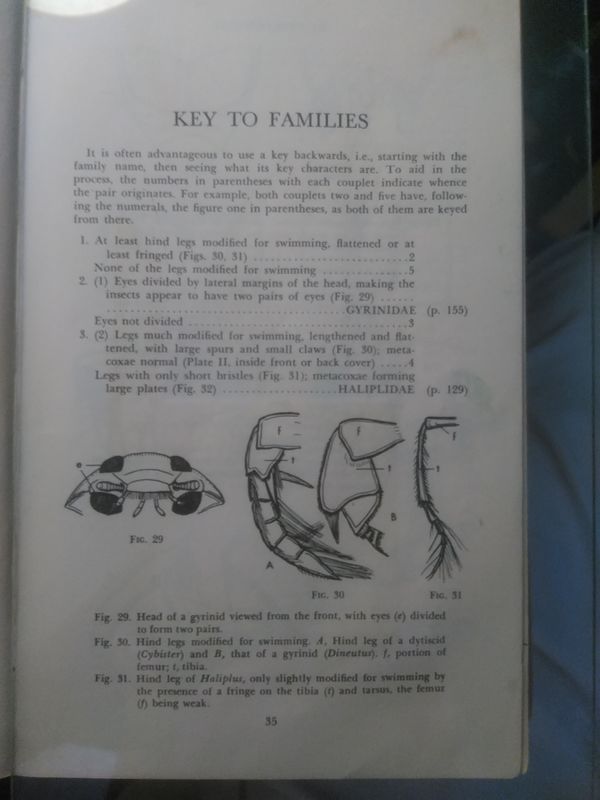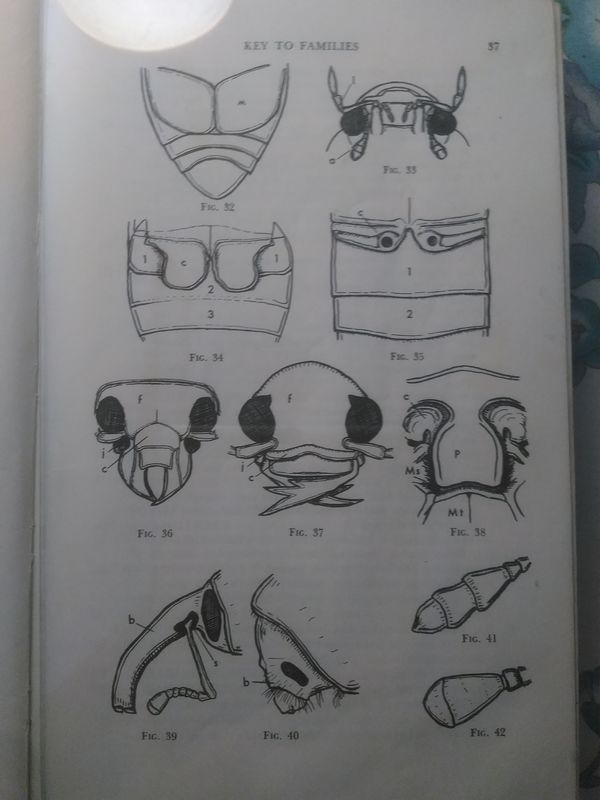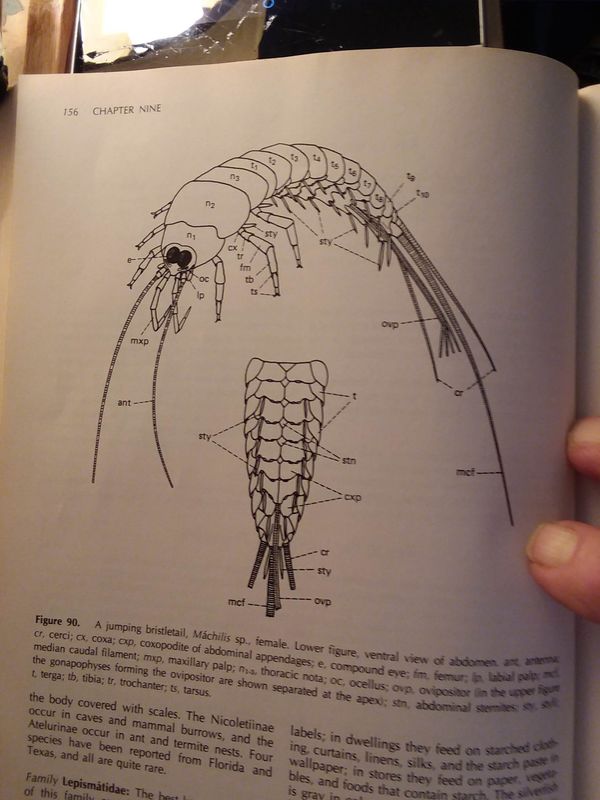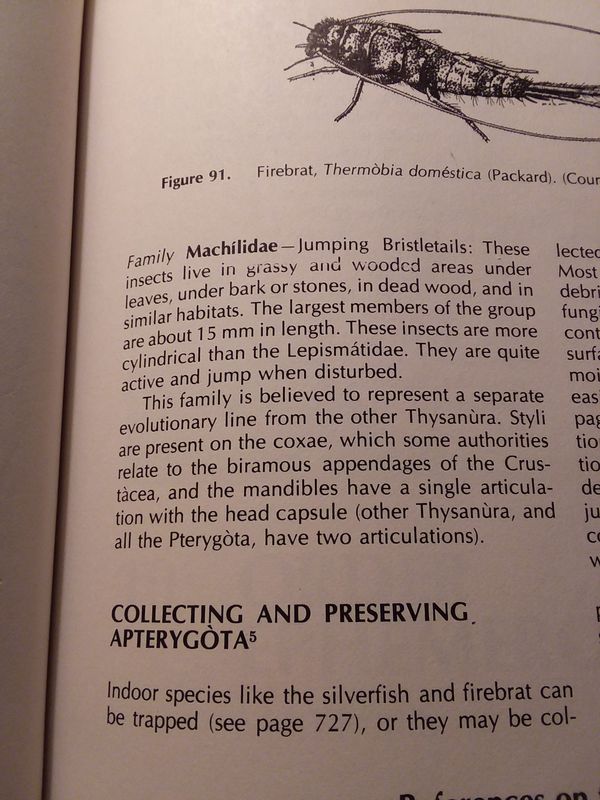Posts for: newtoyou
Dec 14, 2018 14:23:26 #
Curmudgeon wrote:
For a simple explanation of the photos, correct me where I'm wrong newtoyou, it's called a dichotomous key. If you think it's hard to work with think about writing one. The idea is to present you with a question and provide two answers. The answer you choose takes you to another question. Keys can be as basic as asking "Does it have six legs. If yes go to insects. If no go to Question 2."
Correct on all counts till the answer to six legs. Juvenile millipedes have six legs.
Your chalange about writing one. Tried it. Talk about picky!! Never got far.
To run a full key to,say,a weevil, to species might take you thru a hundred, more or less, couplets. All the while knowing the language, knowing key points, and looking thru a microscope. For hours. For real nerds like me,a joy. Solitude, quiet.
Sorry,I ramble.
The overall point being that it is not a simple subject. There will never be definitive answers. Never a true concensus. So why do this? Pleasure.
Some ask questions, some answer, to the benefit of both. The more you know, the more you want to know. I hope I haven't bored you. Lazy afternoon. And I hope my input helps you.
Enjoy the p.m.
Bill
Dec 14, 2018 12:29:19 #
The study of insects, and nature in general has given me a great deal of pleasure. I may become a millionaire thru my insect work. Another 999,500$ to go.
By a closer look at nature, a better understanding of oneself is possible. We are a part of it.
Insects CANNOT be identified by a picture in many(most) instances. Mushrooms another. One common mosquito has been proven by dna and the frequency of the female wingbeat to be seven sister species. To hobbiest or pro, insect study is neverending. Read 'An American Plague'. How Walter Reed and others risked death to find the cause of Yellow Fever. Entomology at work.
One note. The experts at the Smithsonian (I had access to some of them) are usually in the field or writing.The people at Beltsville Ag. Farm are at studies. Profs in college are teaching and writing. In reality, it will be hard to find a pro to look at specimens. An entomologists society is a good way to have identification done, but you need to go to meetings. In truth, there was not much chance to have an ID made until the internet.
BugGuide and others just what an amateur needs, BUT, do not expect 100% success.
I may put in an hour or two or more to ID some of the posts here. First, memory, next, to my books. Then maybe to one of the few monographs I still have. Then to an insect site. BugGuide would be last.
When studying beetle taxonomy, I sometimes worked hours on a microscope, nose in a set of keys(contortionist) before getting it vetted. I was very lucky to have the 'vettor'. He is still doing a checklist of Maryland beetles. My name is in there as collector for hundreds of species. My posterity.
The good news, as Mark said, is just post on UHH. We nerds will take it from there.
Thanks to all. Let me get off this soap box and get moving.
Bill
By a closer look at nature, a better understanding of oneself is possible. We are a part of it.
Insects CANNOT be identified by a picture in many(most) instances. Mushrooms another. One common mosquito has been proven by dna and the frequency of the female wingbeat to be seven sister species. To hobbiest or pro, insect study is neverending. Read 'An American Plague'. How Walter Reed and others risked death to find the cause of Yellow Fever. Entomology at work.
One note. The experts at the Smithsonian (I had access to some of them) are usually in the field or writing.The people at Beltsville Ag. Farm are at studies. Profs in college are teaching and writing. In reality, it will be hard to find a pro to look at specimens. An entomologists society is a good way to have identification done, but you need to go to meetings. In truth, there was not much chance to have an ID made until the internet.
BugGuide and others just what an amateur needs, BUT, do not expect 100% success.
I may put in an hour or two or more to ID some of the posts here. First, memory, next, to my books. Then maybe to one of the few monographs I still have. Then to an insect site. BugGuide would be last.
When studying beetle taxonomy, I sometimes worked hours on a microscope, nose in a set of keys(contortionist) before getting it vetted. I was very lucky to have the 'vettor'. He is still doing a checklist of Maryland beetles. My name is in there as collector for hundreds of species. My posterity.
The good news, as Mark said, is just post on UHH. We nerds will take it from there.
Thanks to all. Let me get off this soap box and get moving.
Bill
Dec 13, 2018 22:25:02 #
tinusbum wrote:
on a kokopelli
I believe you do your own recycled metal sculptures. Very nice. Your photography ain't bad, neither.
The katydid, sorry, is not. It is a CONEHEAD!!! Probably not from Remulac.
From the Orthoptera family Tettigoniidae, as are katydids, but a different sub- family, Coniphorinae. This one may be Neoconocephalus ensigner, a male. The ovipositor on the female is easily seen. Equal in length to abdomen. In katydids, the ovipositor is sickle shaped and shorter.
They are deafening when singing at close range. The jaws are evil. They can inflict a nasty, painful bite(yep, I was a lot more careful with them afterwards).
Good evening again, all.
Bill
Dec 13, 2018 19:21:17 #
sippyjug104 wrote:
I started hunting for insects in the rotted deadfall in the woods and I've come across several critters so far. This one is a tiny Woodlouse which was easy to catch but it was quite the dickens to photograph. I know that it's not the best for several reasons, but it was a good learning experience for me.
I think the photography is fine, I leave that critique to others.
If your presentation is important, and it is to me, too, then studying living specimens is important(imparative). A bumble bee looking robber fly is given away demeanor, very un bumble bee like. This is common.
I have pinned few arthropods other than insects. A woodlouse would(no pun, just a homophone) be hard. My only advise is simple. Keep at it, and enjoy yourself. This is an area that cannot be learned in books. Watch close, a lot to see in a small space when you know how to look. Pinning takes practice.
Nite all.
Bill
Dec 13, 2018 11:56:03 #
Ok, got the shot, what is it?
Go to bug guide, go to UHH , go on line???
Go to 1980. Here are the first five pages of the beetle keys in Dillon and Dillon, Common Beetles of E. N. A.
Have fun.
This is how a beetle, or any creature is ID'ed. Not an easy process. But in time one can jump to a close decision by characters. I see a beetle, I can probably ID to family, by eye(mine,sometimes theirs). This is experience. My encouragement to all who aspire in this field, amatures make enourmous strides in this field. This is not possible in most.
Bill
Go to bug guide, go to UHH , go on line???
Go to 1980. Here are the first five pages of the beetle keys in Dillon and Dillon, Common Beetles of E. N. A.
Have fun.
This is how a beetle, or any creature is ID'ed. Not an easy process. But in time one can jump to a close decision by characters. I see a beetle, I can probably ID to family, by eye(mine,sometimes theirs). This is experience. My encouragement to all who aspire in this field, amatures make enourmous strides in this field. This is not possible in most.
Bill
Dec 13, 2018 11:23:16 #
EnglishBrenda wrote:
I don't know which of the Sawfly larvae this is, any ideas anyone? I found it hiding in a Brussel sprout from the garden.
Well, we all had fun with that one. Identifying insects is not always easy. So as to not hijack, see my upcoming post to general photo.
Bill
Dec 13, 2018 11:09:53 #
tinusbum wrote:
silverfish or firebrat i thought i had good focus but it doesnt enlarge good
and i still have orchard spiders
and i still have orchard spiders
Info from text.
Bill
Dec 13, 2018 11:03:57 #
tinusbum wrote:
silverfish or firebrat i thought i had good focus but it doesnt enlarge good
and i still have orchard spiders
and i still have orchard spiders
The bristletail is in the family Machilidae. The silverfish and firebrats are Lepistomatidae. They run but cannot jump.
The one you shot,the Machilidae, is more outdoor, in leaf litter. They jump quite well.They are more robust than others, more armored.
I am sending the excerp From my Ento text.
A whole different language,in a way.
Bill
Dec 11, 2018 23:58:06 #
EnglishBrenda wrote:
ha ha, there were spiders on the plant, also small snails, a slug and a woodlouse. I love sprouts normally but not so keen on these homegrown ones.
This is conjecture. The caterpillar feces induce fungi. The fungi, in their work, make a more nutritious food. The rots hasten the return of the plant to the nutrition cycle. There are many fungus feeding insects that are only found WITH THE FUNGUS. I have noticed that keeping a lot of greens clean in the garden that in spite of insects, no severe rot, less loss. Have a feeling I am off track. That is from 'scatology 101'. Brenda, thank you, for the post.
Goodnight all. Bill
Dec 11, 2018 18:23:18 #
EnglishBrenda wrote:
Bill thanks, I have looked on the web and I think you are probably right with Plutella zylostella, also I have seen the adult (Diamond back moth) in the garden at times, a very small moth and a difficult to photograph one. I haven't seen the caterpillar before though, at least I have noticed one.
On the web?? It was in a spider web?
Bill😀
Dec 11, 2018 17:15:53 #
sippyjug104 wrote:
I'm learning that lighting is so important and perhaps the most important facet of macro photography. I bow before those who have mastered it. I hope to make it out to IKEA today for two of their JANSJÖ LED flexible gooseneck work lamps that I see in many pictures of macro setups. With them I can light from different directions and try various diffusion techniques.
And as the famous Sherlock Holmes once said, "The game is afoot".
And as the famous Sherlock Holmes once said, "The game is afoot".
And he got it from the Shakespeare play King HENRY IV.
Bill
Dec 11, 2018 17:11:45 #
sippyjug104 wrote:
I also believe in the policy of "do no harm&q... (show quote)
The subject of killing insects seems to pop up on occasion. Wanton destruction and greed are no-no. Over collecting a no- no.
The people who tend to be against this don't seem to mind killing off ant colonies, garden insects, spiders and bugs in general when they are bothered. That they usually have no clue when they buy fungacides,herbacides, pestacides and the like of proper use is OK, tho. I get a kick when they buy bags for leaves,pay to dispose of same, and buy worthless beauty bark to kill the trees come spring. Scientific collecting is not limited to scientists. Entomology is a field where amatures contribute regularly.
I suggest that the people who must comment in a negative way about what YOU do simply do not get enough chance to talk, or may not be listened to at home.
There are people who know that somewhere there are people enjoying life and feel it is there duty to put an end to it. Why????
My opinion. Agree?, fine by me. Disagree?, fine by me. It is only an opinion.
Bill
Dec 11, 2018 16:46:06 #
relbugman wrote:
I'll add a 'non-consensus' opinion, but one that is nor at all sure! I'd go with a moth larva rather than a Pierid, but can't suggest what. The general gestalt seems more mothy than butterfly'y. No rolling? No constructed hides? With piles of frass in the back? Don't know ... Agreed, not a sawfly. Nice shots.
Going by your post, I looked a bit deeper. Maybe Plutella xylostella? I also learned that this moth has only four larval instars, not the usual five.
Bill
Dec 11, 2018 13:13:22 #
EnglishBrenda wrote:
Thanks, job done.
Just because there is a consensus does not mean we are right.
Old entomology proverb.
Bill
Dec 11, 2018 09:52:53 #
napabob wrote:
cool series, have imagined while climbing a slope of sand what it would be like if I was an ant, as memories of dropping them into the funnel sprang to mind..........
Then getting bombarded with sand grains to slide you closer, closer, SNAP!!!






